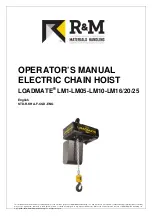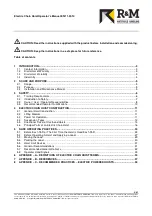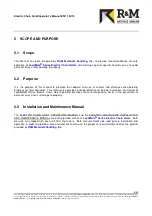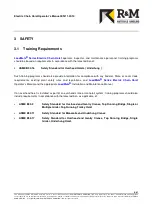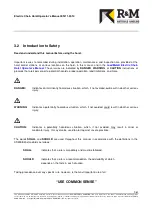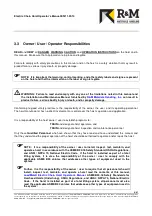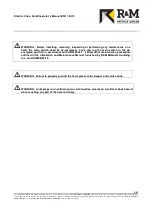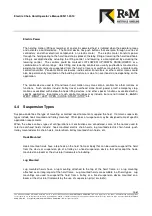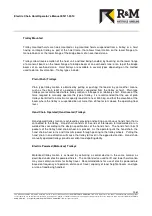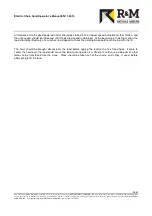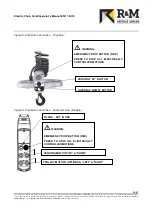
Electric Chain Hoist Operator’s Manual/EN/11.30.10
12/41
This document and the information contained herein, is the exclusive property of R&M MATERIALS HANDLING, INC. and represents a non-public, confidential and proprietary trade
secret that may not be reproduced, disclosed to third parties, altered or otherwise employed in any manner whatsoever without the express written consent of R&M MATERIALS
HANDLING, INC. . Copyright © (2010) R&M MATERIALS HANDLING, INC. . All rights reserved.
Electric Power
The hoisting motion (lifting or lowering) of an electric powered hoist is initiated when the operator grasps
and activates a control device. The control device has push buttons that energize, through a series of
contractors and other electrical components, an electric motor. The electric motor transmits power
through the hoist gearing to the hoist load chain sprocket; thereby, lifting or lowering the hoist load hook.
Lifting is accomplished by actuating the lifting control; and lowering is accomplished by actuating the
lowering control. The controls could be marked: LIFT/LOWER; UP/DOWN; RAISE/LOWER; or a
combination of such markings. Hoist lifting and lowering controls are usually pushbuttons mounted in a
pendant control enclosure suspended from the hoist; or levers or switches mounted in a remote radio-
control transmitter. Pendant control enclosures, radio-control transmitters, or other control means could
also be permanently mounted on the building structure or cab of an overhead crane depending on the
application.
The control device used to lift and lower hoist motion may also contain controls for other motions or
functions. Such controls include: trolley travel, overhead crane travel, power on/off, emergency stop,
motions associated with below-the-hook lifting devices, and other special functions associated with a
specific application. Examples of such control markings may include, but are not limited to, EAST /
WEST; RIGHT / LEFT; OPEN / CLOSE; START / STOP; etc.
4.4 Suspension Types
Suspension defines the type of mounting or method used to mount or suspend the hoist. Common suspension
types include hook mounted and trolley mounted. Other types of suspension may be designed to meet specific
application requirements.
When the above various types of configurations or constructions are considered, some of the names used to
refer to overhead hoists include: hook mounted electric chain hoists, lug mounted electric chain hoists, push
trolley mounted electric chain hoists, motor driven trolley mounted chain hoists, etc.
Hook Mounted
Hook mounted hoists have a top hook on the hoist frame or body that can be used to suspend the hoist
from the clevis or suspension pin of a trolley; or a fixed suspension device, that will accept the hook,
mounted on a beam or the structural framework of a building.
Lug Mounted
Lug mounted hoists have a lug mounting attached to the top of the hoist frame, or a lug mounting
attached as an integral part of the hoist frame. Lug mounted hoists are available in all hoist types. Lug
mountings are used to suspend the hoist from a trolley, or a fixed suspension device mounted on a
beam or the structural framework by the use of suspension pin(s) or stud(s).

